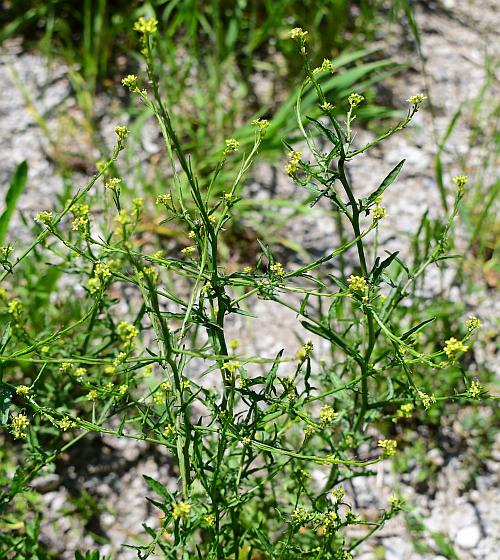Sisymbrium officinale (L.) Scop.
Hedge Mustard

Introduced
CC = *
CW = 5
MOC = 42
© SRTurner
Sisymbrium officinale (L.) Scop.Hedge Mustard | |
 |
Introduced CC = * CW = 5 MOC = 42 |
© SRTurner |
|
Family - Brassicaceae Habit - Annual forb. Stem - Spreading or ascending, to 75 cm, often branched, sparsely to usually densely hairy, especially near the base.
Leaves - Alternate, 2-20 cm long, hairy or the uppermost leaves sometimes nearly glabrous, the middle and lowermost leaves petiolate, lanceolate to lanceolate-triangular in outline, pinnately lobed or divided into 3-11 lobes, these entire to irregularly toothed or lobed, the uppermost leaves often sessile, triangular to narrowly lanceolate in outline, entire or pinnately 3-5 lobed, the lobes entire or few-toothed.
Inflorescences - Short racemes from branch tips, elongating in fruit.
Flowers - Sepals 1.0-2.0 mm long, oblong, erect. Petals 2.5-4.0 mm long, not lobed, yellow. Stamens 6. Style 1.0-1.5 mm long at fruiting.
Fruits - Siliques 0.7-1.8 cm long, erect, appressed to the inflorescence axis, the stalk 1.5-3.0 mm long, relatively stout, about as wide as the fruit. Seeds 10-20 per fruit, 1.0-1.3 mm long. Flowering - May - October. Habitat - Streambanks, crop fields, pastures, farmyards, railroads, roadsides, open disturbed areas. Origin - Native to Eurasia. Lookalikes - Broadly, other species of Sisymbrium, other mustards. Other info. - This introduced weed is found in scattered locations in Missouri, predominantly in the southern half of the state. It also occurs at least sporadically in nearly every U.S. state. It is recognized by its small yellow flowers, which typically occur in small clusters at the branch tips, and its linear fruits which are tightly appressed to the inflorescence axis. These two characters give the inflorescence branches a distinctive appearance which renders the plant easy to identify. A favored habitat of the plant is the marginal area of crop fields. Photographs taken along the Katy Trail near Treloar, Warren County, MO, 5-2-2020 (SRTurner). |